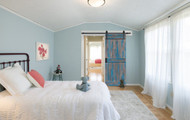Choosing the Perfect Home Color Palette
Jun 7th 2017
When moving into a new house or deciding to change the look of your current one, you might find yourself overwhelmed by the task of decorating the space. It’s hard to know where to start and how to build the ideas you’ve envisioned. Many find that picking a home color palette makes it much easier to decorate and customize their home. If you’ve never chosen a color palette for a residential space before, use these helpful tips to find the right hues for your home.
Understanding Color Palettes
Think back to your grade school art classes. Remember the color wheel? Selecting a home color palette starts with an understanding of how the colors relate to one another on the wheel. A color palette for your home will fall into one of four categories.
- Monochromatic: A palette consisting of different shades of the same color (for example, navy blue, sky blue, periwinkle, etc.). These palettes are ideal for those with modern tastes that want their home to look clean and sleek.
- Analogous: These are colors that appear next to one another on the color wheel. So an analogous palette could include shades of purple, red, and orange. These color palettes provide a harmonious feeling to a house.
- Contrast: This palette is more dramatic as it uses colors that are from different segments of the color wheel not located near each other. For example, pink and blue would be contrasting colors. Using combinations of main colors from the color wheel, such as red-orange, yellow-green, or blue-purple provides a subtle way to introduce more color variations into your home.
- Complementary: You would think the combination of two opposing colors, like red and green, would be an affront to the eyes. However, as we all know, there’s nothing quite as welcoming and cheerful than the colors of Christmas. This applies to combining the other opposing colors on the wheel, like blue and orange or yellow and purple. These lively combinations add so much personality to a home.
How to Choose the Perfect Home Color Palette
Now that you understand how colors work together to create a cohesive palette for your home, it’s time to start picking the tones you want to use. As you create your home color palette, consider these suggestions:
- Your starting point will be the brightest or boldest color you want to use.
- Stick to three to five colors.
- Play around with a color palette generator to get ideas. This helps you visualize the palette you have in mind without committing to anything.
- Consider the pieces you already have in your home, such as a patterned couch or an area rug. Look at the colors of those pieces and build your palette off of them.
- Contrast warm and cool tones for a well-balanced palette.
- Do not select your wall color first. Instead build around existing furniture and home decor accessories, or any pieces you plan on purchasing. Once you’ve invested in or decided on those pieces, you can determine whether you need to add more color or if you should stick to a neutral for the walls.
It’s important to remember than no matter what palette you choose, you should also incorporate some neutral colors into your color palette, especially when using contrasting or complementary colors. Neutral colors like white, gray, beige or black will make your colors stand out without looking busy or overwhelming. These colors are great for hard materials that are not as easy to change like tile, flooring, or large pieces of furniture.
Use the Rule of 60-30-10
The time has arrived to put your home color palette to work. Of course you don’t want to use too much of any one particular color so use the Rule of 60-30-10. "When decorating a space, divide the colors into components of 60 percent of a dominant color (walls), 30 percent of a secondary color (upholstery) and 10 percent of an accent color (accessories)," advises designer Mark McCauley. “This ratio ensures that the colors are properly balanced and there's just enough pop for interest."
Once you’ve decorated with your color palette, you’ll find that there’s a new flow and energy in your home. Over time, you’ll continue to play around with your home color palette as you add furniture and art to your house. Remember to have fun experimenting with different applications of your color palette, such as with an accent wall or a standout piece, like a Knotty Alder BarnWood Sliding Barn Door.
